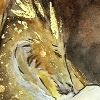Sign In
CloseEchos of Furry/Therianthropy/Otherkin in Central America by Cassander
There's an exhibit of Central American ceramics at the Museum of the American Indian here in DC. It's about to close, actually, and I finally got around to reading the booklet about the exhibit which features essays on indigenous Central American cultures. In one of the essays, even before I came across the word "therianthropy" itself, I started to notice many parallels to the practices and beliefs of modern furries, therians, and otherkin.
Although the article is interesting itself, it's something of an overview or survey of the subject. The references would probably be good places to look for more information.
The article is called Authority in Ancestral Central America and starts on page 45 (page 46 by the PDF's counting): http://www.latino.si.edu/PDF/Revealing_Ancestral_Central_America.pdf
Here is one especially interesting passage, but I recommend reading the whole article for context and because there's interesting stuff about appropriating the other in for various ends. Also draws very interesting parallels between various forms of ancient and modern cultural appropriation.
Authority from Nature
The power of mimesis and connections through kinship are frequently evidenced in representations of the imaginary transformation of humans into animals: therianthropy (Figure 75). Humans could be thought to manifest the powers of those animals through “becoming” or imitating them. Expressions of this concept are varied and complex, from ideas of animal ancestors and clan founders to accessing animal co-essences or alternative identities (alter-egos) through trance or dreams. Animals frequently figure into creation stories, which were used to provide justification for a specific social order (Figure 76).
Interpreting depictions of therianthropy is always difficult because it is often impossible to distinguish among animals being portrayed with human characteristics, humans being portrayed with animal characteristics, supernatural beings, or people wearing costumes (Figure 77). This is further complicated by differences between etic (outsider) and emic (insider) interpretations. While an outside observer may interpret someone in costume as imitating an animal, a member of the group might interpret them as actually being that animal (or a person-animal, since these separate identities are rarely clear). Whose perspective is correct becomes, ironically, a matter of authority. In therianthropy, manipulation of this ambiguity itself becomes a source of power. In Classic Maya culture, the concept of a way, a spiritual co-essence that is part of a person, represented in animal form, may be related to an alternative animal identity that a person such as a ruler can actually become. The power of alterity was manifest in appropriating aspects of this animal “other” through the use of things associated with it. Maya rulers, for example, would wear jaguar skins to represent their possession of jaguarlike strength, cunning, stealth, dominance, and knowledge of the ecosystem (and of human society). Jaguar figures adorning incense burners used in ritual (Figure 78) made explicit the connection between the authority of association with this animal, and the authority based on ritual practice.
In Costa Rica, warriors portrayed in stone sculpture are shown wearing broad belts of what appears to be crocodile hide, which may have served both as practical protection and to indicate possession of a crocodile’s ferocity and toughness. Skins, claws, feathers, bones, and many other animal parts were worn to represent appropriation of power from those beings. The ability to successfully appropriate these qualities could become a source of authority (Figure 79). Detailed, empirically based knowledge and understanding of predators in the ecosystem (jaguars, crocodiles, harpy eagles, king vultures, snakes, sharks, among others) provided inspiration for costumes and symbols of authority, like a shell pendant from Panama depicting a crocodilian (Figure 80). It is difficult to know for sure, but these may have been as significant for the wearers as they were for their audiences, conferring an internal sense of confidence and power while at the same time communicating externally to others that same perception. We see the confidence of people of all kinds occupying positions of sufficient authority to have been memorialized in shell, jade, gold, stone, and especially in the highly malleable clay that formed the most common medium for human representation (Figure 81). Through material culture, authority was made visible in ancestral Central America—even when its sources were invisible.
Journal Information
- Views:
- 198
- Comments:
- 0
- Favorites:
- 0
- Rating:
- General

